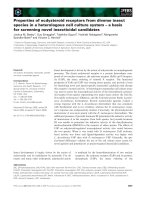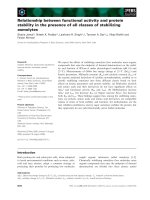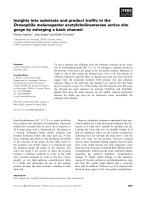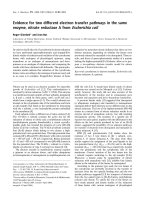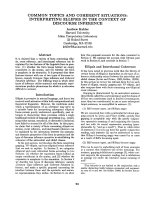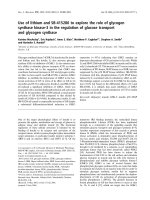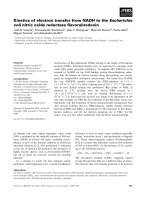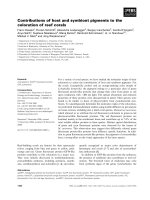Báo cáo khoa học: Existence of novel b-1,2 linkage-containing side chain in the mannan of Candida lusitaniae, antigenically related to Candida albicans serotype A potx
Bạn đang xem bản rút gọn của tài liệu. Xem và tải ngay bản đầy đủ của tài liệu tại đây (487.85 KB, 11 trang )
Existence of novel b-1,2 linkage-containing side chain in the mannan
of
Candida lusitaniae
, antigenically related to
Candida albicans
serotype A
Nobuyuki Shibata
1
, Hidemitsu Kobayashi
2
, Yoshio Okawa
1
and Shigeo Suzuki
3
1
Second Department of Hygienic Chemistry, Tohoku Pharmaceutical University, Sendai, Miyagi, Japan;
2
Department of Nutrition,
Faculty of Home Economics, Kyushu Women’s University, Kitakyushu, Fukuoka, Japan;
3
Sendai Research Institute for Mycology,
Sendai, Miyagi, Japan
The antigenicity of Candida lusitaniae cells was found to be
thesameasthatofCandida albicans serotype A cells, i.e.
both cell wall mannans react with factors 1, 4, 5, and 6 sera
of Candida Check. However, the structure of the mannan
of C. lusitaniae was significantly different from that of
C. albicans serotype A, and we found novel b-1,2 linkages
among the side-chain oligosaccharides, Manb1fi2Manb1fi
2Mana1fi2Mana1fi2Man (LM5), and Manb1fi2Man-
b1fi2Manb1fi2Mana1fi2Mana1fi2Man (LM6). The
assignment of these oligosaccharides suggests that the
mannoheptaose containing three b-1,2 linkages obtained
from the mannan of C. albicans in a preceding study con-
sisted of isomers. The molar ratio of the side chains of
C. lusitaniae mannan was determined from the complete
assignment of its H-1 and H-2 signals and these signal
dimensions. More than 80% of the oligomannosyl side
chains contained b-1,2-linked mannose units; no a-1,3 link-
ages or a-1,6-linked branching points were found in the side
chains. An enzyme-linked immunosorbent inhibition assay
using oligosaccharides indicated that LM5 behaves as
factor 6, which is the serotype A-specific epitope of
C. albicans. Unexpectedly, however, LM6 did not act as
factor 6.
Keywords: Candida lusitaniae; mannan; NMR analysis;
serotype A; b-1,2-linkage.
The first description of the serological heterogeneity in
Candida albicans was reported by Hasenclever and Mitchell
[1]. These researchers revealed that this species could be
divided into two serotypes, A and B, by agglutination
reaction between heat-killed whole cells of C. albicans
strains and rabbit anti-C. albicans whole cell sera of both
serotypes absorbed with whole cells of another serotype.
Later, Tsuchiya and collaborators [2] conducted an exten-
sive serological study on a variety of yeasts based on the
ability to agglutinate rabbit antiserum of other heat-killed
fungal cells; from these data they developed a series of
absorbed factor sera. ÔCandida CheckÕ, a commercially
available kit containing 10 factor sera is an effective tool for
identifying the cells of Candida species in clinical specimens.
Candida lusitaniae can be pathogenic and cause nosoco-
mial infection in immunocompromised patients, predomin-
antly in granulocytopenic patients undergoing cytoreductive
chemotherapy for acute leukemia and in bone marrow
transplantation recipients [3–6]. Although this species is less
virulent than most other Candida species, it is important
because of its propensity to develop resistance to antifungal
agents, including amphotericin B [5–8]. C. albicans serotype
A strains have been isolated predominantly from patients
with invasive candidiasis. However, C. lusitaniae expresses
the same antigenic pattern as that of C. albicans serotype A,
i.e. both cell strains have antigenic factors 1, 4, 5 and 6
[9,10]. Therefore, it is difficult to distinguish these strains
from the antigenic pattern alone.
ThecellwallmannanofC. albicans serotype A is
composed of an a-1,6-linked backbone moiety and an
oligomannosyl side-chain moiety consisting of a-1,2-, a-1,3-,
and b-1,2-linked mannose units. Furthermore, a small
number of a-1,6-linked branching mannose units may be
present in the side chain. In addition to this acid-stable
structure, there is also a region composed of b-1,2-linked
oligomannosyl residues linked through a phosphate group
to the side chain. Because the phosphodiester linkage is acid-
labile, we can selectively release the b-1,2-linked manno-
oligosaccharides by treatment with 10 m
M
HCl. We have
shown that factor 6 serum reacts with acid-stable oligo-
mannosyl side chains containing b-1,2 and a-1,2 linkages –
the serotype A-specific structure – and that factor 5 serum
reacts with the acid-labile b-1,2-linked oligomannosyl
moieties [11].
We have reported the presence of three kinds of b-1,2
linkage-containing side chains in the mannans from Can-
dida species [11–17]. Because the b-1,2-linked mannose unit
is present among the pathogenic fungi only in the mannan
of the genus Candida and the b-1,2 linkage-containing side
chains behave as strong antigens, many workers [18–25]
have produced monoclonal antibodies to b-1,2-linked
mannose units to protect against candidiasis, for the
serodiagnosis of candidiasis, or for the identification of
mechanisms of Candida infection. Furthermore, studies
have indicated the b-1,2-linked mannose units participate in
Correspondence to S. Suzuki, Sendai Research Institute for Mycology,
1-14-34 Toshogu, Aoba-ku, Sendai, Miyagi 981–0908, Japan.
Fax: + 81 22 2754246, Tel.: + 81 22 2754680.
(Received 7 November 2002, revised 20 March 2003,
accepted 16 April 2003)
Eur. J. Biochem. 270, 2565–2575 (2003) Ó FEBS 2003 doi:10.1046/j.1432-1033.2003.03622.x
the adherence of Candida cells to mammalian cells as the
first step in infection [26–28]. Poulain and his coworkers
[29–32] reported that the b-1,2 linkage-containing oligosac-
charides and phospholipomannans induce cytokine pro-
duction and may act as a virulent factor in candidiasis.
Therefore, it is important to determine the detailed chemical
structure of the cell wall mannan, especially the b-1,2
linkage-containing side chains.
In earlier structural studies by NMR, we identified
almost all of the H-1–H-2-correlated cross-peaks of the
C. albicans serotype B [33], Candida stellatoidea [34],
Candida guilliermondii [17], and Candida saitoana [35]
mannans from assignment of the H-1 and H-2 signals of
many mannooligosaccharides. Although the H-1 proton
signal provides the best information on the glycosidic
linkage, several H-1 signals overlap. The H-2 signal, a
second structure reporter, can resolve the overlapped H-1
signals into H-1–H-2-correlated cross-peaks; therefore, we
were able to determine the dimensions of the resolved H-1
signals using the two-dimensional (2D) HOHAHA spec-
trum. Because the ratio of the mannose units is propor-
tional to that of the corresponding signal dimensions, we
can estimate the molar ratio of the side chains. However,
we have not completely assigned the H-1–H-2-correlated
cross-peaks of the mannan of C. albicans serotype A yet,
because the mannan produces a spectrum containing a
very complicated pattern of cross-peaks. However, the
2D-HOHAHA spectrum of C. lusitaniae mannan was
simpler than that of the C. albicans serotype A mannan,
whichpromptedustoassignthecross-peaksofC. lusit-
aniae mannan first. These accumulated data will make it
possible for us to predict the structures of other mannans
from their 2D-HOHAHA spectra.
The object of this study was to determine the detailed
chemical structure of the mannan of C. lusitaniae,whichis
antigenically related to C. albicans serotype A, using NMR
techniques with the aim of elucidating the complete
structure of the C. albicans serotype A mannan.
Experimental procedures
Materials
The C. lusitaniae IFO 1019 strain was obtained from the
Institute for Fermentation (Osaka, Japan). The C. albicans
J-1012 strain (serotype A) mannan was the same specimen
used in preceding studies [11,16]. Factors 1, 4, 5, 6, 9, and
13b sera of ÔCandida CheckÕ (lot number I675), a commer-
cially available kit containing rabbit polyclonal antibodies
to Candida cells, were purchased from Iatron (Tokyo,
Japan). Except for factor 1 serum, which is unabsorbed
rabbit whole-cell serum against C. albicans cells, factors 4,
5, 6, and 13b sera are anti-C. albicans sera absorbed with
cells of Candida parapsilosis, C. guilliermondii, C. stellato-
idea,andCandida tropicalis, respectively. Factor 9 serum is
anti-C. guilliermondii serum absorbed with cells of
C. albicans [2]. Jack bean a-mannosidase (EC 3.2.1.24)
was obtained from Sigma. Haptenic oligosaccha-
rides, Manb1fi2Mana1fi3Mana1fi2Mana1fi2Man and
Manb1fi2Manb1fi2Mana1fi3Mana1fi2Mana1fi2Man
were prepared from the mannan of C. guilliermondii [17]
or C. saitoana [35] and Manb1fi2Mana1fi2Mana1fi
2Mana1fi2Man and Manb1fi2Manb1fi2Mana1fi
2Mana1fi2Mana1fi2Man were obtained from the man-
nan of C. albicans J-1012 (serotype A) [16].
Preparation of mannan
Yeast cells were grown at 28 °C with shaking in a liquid
culture containing 0.5% yeast extract, 1% peptone, and 2%
glucose. Mannan was extracted from the cells with water at
135 °C for 3 h and was separated by precipitation with
Fehling’s solution [33]. The mannan prepared from the cells
of the C. lusitaniae IFO 1019 strain was designated Fr. L.
Acid treatment of mannan
To determine the amount of acid-labile phosphodiesterified
oligosaccharides in the mannan, 500 mg of Fr. L were
dissolved in 50 mL of 10 m
M
HCl,andheldat100°Cfor
1 h [13]. After cooling, the reaction mixture was neutralized
with 100 m
M
NaOH and was separated by column
chromatography (2.5 · 100 cm) using Bio-Gel P-2 (extra
fine). Elution was conducted with water, and aliquots of the
eluates were assayed for carbohydrate content using the
phenol–sulfuric acid method [36]. Because this treatment
cleaves the phosphodiester linkage, the acid-stable moiety of
the mannan is eluted in the void volume and the manno-
oligosaccharides released from the mannan are retained by
the column. The acid-stable moiety of the mannan was
designated Fr. L-a.
Acetolysis of mannan
Acetolysis under mild conditions [37] was performed as
previously described [38]. Briefly, acetylated mannan was
dissolved in 100 : 100 : 1 (v/v/v) acetic anhydride–acetic
acid–sulfuric acid and held at 40 °C for 36 h. After
deacetylation using sodium methoxide, fractionation of
the resultant mannooligosaccharide mixture was achieved
by HPLC. This treatment selectively cleaves the backbone
a-1,6 linkages and yields an oligosaccharide mixture that
originates from the oligomannosyl side-chain moieties.
HPLC of oligosaccharides
HPLC was carried out using a column (10 · 500 mm) of
YMC-Pack PA-25. Elution was carried outwith 52 : 48 (v/v)
CH
3
CN–water, and the eluates monitored using a differen-
tial refractometer [17]. Eluates corresponding to each peak
were rechromatographed on the same column.
Nuclear magnetic resonance spectroscopy
All
1
H NMR experiments were performed with a JEOL
JNM-GSX 400 spectrometer at 400 MHz. The spectra were
recorded using a 1% (w/v) solution of each mannan or
oligosaccharide in 0.7 mL of D
2
Oat45°C with acetone
(2.217 p.p.m.) [39] as the internal standard.
Enzyme-linked immunosorbent inhibition assay
The enzyme-linked immunosorbent assay was conducted
as described previously [11]. Assays using factor sera were
2566 N. Shibata et al. (Eur. J. Biochem. 270) Ó FEBS 2003
conducted basically as described by Okawa et al.[40].A
haptenic oligosaccharide solution (50 lL) was mixed with a
100-fold dilution of factor 6 serum (50 lL) and preincu-
bated at 25 °C for 2 h. The reaction mixture was then added
to the wells of a Fr. L-a-coated microtiter plate and
incubated at 25 °C for 2 h. After washing, a 1000-fold
dilution of goat anti-(rabbit IgG) antibody–peroxidase
conjugate (100 lL)wasaddedtothewellsandheldat
25 °C for 2 h. Finally, a substrate solution of 0.01%
o-phenylenediamine and 0.03% H
2
O
2
in 150 m
M
citrate
buffer (pH 5.0) (100 lL) was added, followed by the
addition of 2
M
H
2
SO
4
(50 lL), and the color measured
at 492 nm.
Other methods
For a-mannosidase treatment, the mannooligosaccharide
mixture (200 mg) was dissolved in 50 m
M
sodium acetate
buffer (pH 4.6; 2 mL) containing 20 U of a-mannosidase.
After incubation at 37 °C for 48 h, the reaction mixture was
boiled for 5 min to deactivate the enzyme. Total carbohy-
drate content was determined by the phenol–sulfuric acid
method of Dubois et al. [36] with
D
-mannose as the
standard.
Results
Prediction of the structure of Fr. L from its 2D-HOHAHA
spectrum
Fr. L showed strong reactivity with factor 1, 4, 5 and 6 sera
on ELISA (Fig. 1), indicating that this mannan possesses
the same antigenic determinants as those of C. albicans
serotype A [11]. Therefore, we compared the structures
of the two mannans using their 2D-HOHAHA spectra.
Figure 2 shows the H-1 region (% 4.7–5.6 p.p.m.) of the
one-dimensional (1D) NMR spectrum and the 2D-H-1–
H-2-correlated cross-peaks of Fr. L and the mannan of
C. albicans J-1012. The H-1 region of Fr. L gave relatively
simple signals in the a-anomeric region (% 4.9–5.6 p.p.m.)
and signals at the b-anomeric region (% 4.7–4.9 p.p.m.) that
were two times larger than the 1D-NMR signals of the
mannan of C. albicans J-1012. Several structural differences
between the mannans are apparent. The differences between
cross-peaks 5, 6, 7 and 8, which correspond to a-1,2-linked
mannose units in the mannans, suggests differences in the
lengths of the a-1,2-linked side-chain moieties. The spec-
trum of Fr. L does not show cross-peaks 3, 4, 9 or 17, which
correspond to a-1,3-linked mannose units or 3-O-substi-
tuted ones. Furthermore, Fr. L does not show cross-peaks
4, 8, 15, 18, 19 or 30, suggesting that the mannan does not
have b-1,2-substituted a-1,3-linked mannose units or a-1,6-
linked branching mannose units [17,33–35,38,41]. In con-
trast, both mannans contain cross-peaks 25, 27, and 28,
which correspond to the b-1,2-linked mannose units
[17,35,38].
Acid treatment of Fr. L
To determine the structures and amounts of the phospho-
diesterified oligosaccharides, we treated Fr. L with 10 m
M
HCl at 100 °C for 60 min. As shown in Fig. 3, the released
oligosaccharide was predominantly triose. The
1
HNMR
spectrum of the triose was identical to that obtained from
the mannan of C. albicans [14,42–44], indicating that it is the
b-1,2-linked mannotriose. The polysaccharide moiety eluted
in the void volume fraction was designated Fr. L-a.
Acetolysis of Fr. L-a
Figure 4A shows the HPLC elution pattern of the aceto-
lysate of Fr. L-a from a YMC PA-25 column. Oligosac-
charides up to hexaose were obtained from this
fractionation. These oligosaccharides were then digested
with a-mannosidase, and the reaction products separated by
HPLC (Fig. 4B). The resistance of tetraose, pentaose, and
hexaose to a-mannosidase degradation indicates that these
oligosaccharides contain b-linkages. The oligosaccharides
from tetraose to hexaose obtained by a-mannosidase
treatment were designated LM4 to LM6.
1
H NMR analysis of oligosaccharides
Figure 5 shows the H-1 region of the
1
HNMRspectraof
M3 and LM4 to LM6. As we expected, the signals
corresponding to the b-1,2-linked mannose units from
4.776 to 4.918 p.p.m. were present in LM4, LM5 and LM6.
Although the signals corresponding to the b-1,2-linked
mannose units of LM4 and LM5 (4.776–4.853 p.p.m) were
the same as those of the one and two b-1,2 linkage-
containing oligosaccharides, respectively, obtained from
Candida mannans, the 2 : 1 ratio of signal intensities at
4.918 and 4.845 p.p.m. of LM6 was different from the
corresponding three b-1,2 linkage-containing mannohepta-
ose and mannopentaose obtained from the mannans of
Fig. 1. Enzyme-linked immunosorbent assay of Fr. L. The assay was
carried out using the factor sera of Candida Check. s, factor 1 serum;
d, factor 4 serum; n,factor5serum;m, factor 6 serum; h,factor9
serum; j, factor 13b serum. These reactivities were exactly the same as
those of the mannan of C. albicans serotype A [11].
Ó FEBS 2003 Structure of C. lusitaniae mannan (Eur. J. Biochem. 270) 2567
Fig. 2. Two-dimensional HOHAHA spectra of
Fr. L and the mannan of C. albicans J-1012
(serotype A). The boxed or circled regions in
the spectra indicate the H-1–H-2-correlated
cross-peaks, except for cross-peak 30, which
indicates an H-1–H-4 correlated one. The
circledregionscorrespondtotheb-mannose
units in the phosphodiesterified acid-labile
b-1,2-linked mannooligosaccharide. Assign-
ments of these cross-peaks are shown in
Table 2.
Fig. 3. Determination of the phosphodiesterified acid-labile oligosac-
charide. Fr. L was treated with 10 m
M
HCl at 100 °C for 1 h, and the
degradation products were separated using a column (2.5 · 100 cm) of
Bio-Gel P-2 (A). In addition to a peak in the void volume (Fr. L-a),
one oligosaccharide peak (fractions 109–118) was recovered. The
1
H
NMR spectrum (B) of the released oligosaccharide was identical to
that of the b-1,2-linked mannotriose [43].
Fig. 4. Elution patterns of oligosaccharides obtained from Fr. L-a by
acetolysis. HPLC was performed with a YMC PA-25 column
(10 · 500 mm) (A) before and (B) after a-mannosidase treatment.
Elution was carried out with 52 : 48 (v/v) CH
3
CN–water. Acetolysis
was performed with (CH
3
CO)
2
O–CH
3
COOH–H
2
SO
4
(100 : 100 :
1 v/v/v) at 40 °C for 36 h. M1, M2, M3 and M4 indicate mannose,
a-linked mannobiose, mannotriose, and mannotetraose, respectively.
LM4, LM5, and LM6 indicate the b-linkage-containing mannotetra-
ose, mannopentaose, and mannohexaose, respectively.
2568 N. Shibata et al. (Eur. J. Biochem. 270) Ó FEBS 2003
C. albicans serotype A [16] and Citeromyces matoritensis
[45], respectively. As the a-1,6-linked mannose unit also
shows a signal at about 4.91 p.p.m. [17,33,34], we cannot
assign the signal from 1D-NMR. Therefore, we analyzed
these b-1,2 linkage-containing oligosaccharides using
2D-NMR.
Sequential NMR assignment
Sequential assignment of the H-1 and H-2 signals of LM4,
LM5, and LM6 was performed using the NOE cross-peaks
of the NOESY spectrum by the method described by Her-
nandez et al. [46] with slight modifications [17,43] (Fig. 6).
The NOE cross-peaks labeled with primed letters indicate
through-space inter-residue H-1–H-2¢ connectivities be-
tween two adjacent mannose units. The boxed cross-peaks
labeled with unprimed letters indicate intraresidue H-1–
H-2-correlated cross-peaks. Inter-residue cross-peaks due to
dipolar coupling are identified by their absence from a
COSY spectrum (not shown), which shows only the
intraresidue cross-peaks due to J coupling. Using this
procedure, the H-1 and H-2 signals of LM4 were sequen-
tially assigned as shown in the leftmost panel of Fig. 6.
The spectrum in this panel shows inter-residue H-1–H-2¢
connectivities between a reducing terminal mannose unit
(Man-A) with an H-1 signal at 5.348 p.p.m. and a mannose
unit with an H-1 signal at 5.276 p.p.m. (A2–A2¢–B2), and
between the latter (Man-B) and a mannose unit with an
Fig. 5. The anomeric region of the
1
HNMR
spectra of oligosaccharides obtained from
Fr. L-a by acetolysis. Spectra were recorded
usingaJEOLJNM-GSX400spectrometerin
D
2
Oat45°C using acetone as the internal
standard (2.217 p.p.m.). LM4, LM5 and LM6
are designated as indicated in the legend of
Fig. 4.
Fig. 6. Partial NOESY spectra of LM4, LM5,
and LM6. Sequential assignment of the H-1
and H-2 signals was performed using NOESY
and COSY spectra. Primed letters indicate
inter-residue H-1–H-2¢-NOE cross-peaks and
unprimed letters indicate intraresidue H-1–
H-2-correlated cross-peaks, caused by J coup-
ling, e.g. A2 indicates the H-1–H-2-correlated
cross-peak of the reducing terminal mannose
unit, Man-A, and A2¢ indicates the inter-resi-
due NOE cross-peak between the H-2 of Man-
A and the H-1 of an adjacent mannose unit,
Man-B. By this procedure, the H-1 and H-2
signals were sequentially assigned from the
H-1 of Man-A, A2–A2¢–B2–B2¢–C2–C2¢–D2
for LM4.
Ó FEBS 2003 Structure of C. lusitaniae mannan (Eur. J. Biochem. 270) 2569
H-1 signal at 5.160 p.p.m. (B2–B2¢–C2). Moreover, inter-
action between Man-C and the b-linked mannose unit with
an H-1 signal at 4.776 p.p.m. (C2–C2¢–D2) is seen, indica-
ting that LM4 has the following structure:
DC BA
Manb1!2Mana1 !2Mana1!2Man (LM4)
The H-1 and H-2 signals of LM5 and LM6 were also
sequentially assigned from the H-1 of Man-A, A2–A2¢–B2–
B2¢–C2–C2¢–D2–D2¢–E2 and A2–A2¢–B2–B2¢–C2-C2¢–
D2–D2¢–E2–E2¢–F2, respectively. Although the H-1 of
Man-E and Man-F of LM6 gave almost the same chemical
shifts, we could assign the H-2 signal (not shown) of the
nonreducing terminal b-1,2-linked mannose unit as the
signal with a chemical shift at about 4.14 p.p.m. from
the assignments of the phosphodiesterified b-1,2-linked
mannooligosaccharides [42,43]. Therefore, we could unam-
biguously assign the H-1–H-2-correlated cross-peaks E and
F. These results indicate that LM5 and LM6 have the
following structures:
EDCBA
Manb1!2Manb1!2Mana1!2Mana1!2Man(LM5)
FE DC BA
Manb1!2Manb1!2Manb1!2Mana1!2Mana1!2Man
(LM6)
These assignment results indicate that cross-peaks 22, 23,
and 24 on the 2D-HOHAHA spectrum in Fig. 2 corres-
pond to Man-E, -F, and -D of LM6, respectively.
We also assigned other ring protons using the
2D-HOHAHA spectra; the results are shown in Table 1.
Although a small number of side chains with the same
structure of LM4 has been found in the mannan of
C. glabrata [47], LM5 and LM6 are novel oligosaccharides.
Determination of the molar ratio of mannan
side chains
The molar ratio of the mannan side chains was calculated
using the dimensions of the specific H-1 and H-2 signals
corresponding to each side chain based on assignment
results of the cross-peaks on the 2D-HOHAHA spectra
(Fig. 2) as previously described [17,34,35]. The H-1 signal of
the mannan from C. lusitaniae at 5.152 p.p.m. overlaps two
signals at 5.160 p.p.m. and 5.138 p.p.m. corresponding to
cross-peaks 20 and 21, respectively, as shown in Fig. 2, and
the amount of the two signals was 15.5% of the total H-1
signal dimension (Table 2). These signals were assigned as
H-1 of the mannose unit substituted by b-1,2 linkages in
LM4, LM5, and LM6. The H-1 signal at 4.778 p.p.m. and
H-2 signal at 4.401 p.p.m. (not shown) simply correspond
to cross-peaks 28 and 22, respectively, and both were
1.9% of the total dimension. Cross-peaks 28 and 22 were
identified as the one and three b-1,2 linkage-containing
oligomannosyl side chains, LM4 and LM6, respectively.
Therefore, the amount of the two b-1,2 linkage-containing
Table 1. Chemical shifts of the oligosaccharides obtained by acetolysis. ND, not determined.
Sugar residue Chemical shift
Oligosaccharide F E D C B A F E D C B A
LM4 Manb1fi2Mana1fi2Mana1fi2Mana
H-1 4.776 5.160 5.276 5.348
H-2 4.035 4.274 4.118 3.932
H-3 3.644 3.858 3.956 3.945
H-4 3.579 3.695 3.673 3.693
H-5 3.379 ND ND ND
H-6 3.919 3.858 3.871 3.860
H-6¢ 3.738 3.759 3.738 3.499
LM5 Manb1fi2Manb1fi2Mana1fi2Mana1fi2Mana
H-1 4.841 4.853 5.140 5.262 5.340
H-2 4.148 4.261 4.251 4.113 3.933
H-3 3.610 3.655 3.887 3.954 3.944
H-4 3.567 3.598 3.605 3.667 3.692
H-5 3.348 3.389 ND ND ND
H-6 3.914 3.916 3.854 3.866 3.854
H-6¢ 3.728 3.756 3.731 3.733 3.780
LM6 Manb1fi2Manb1fi2Manb1fi2Mana1fi2Mana1fi2Mana
H-1 4.918 4.914 4.845 5.150 5.267 5.345
H-2 4.147 4.399 4.245 4.265 4.119 3.940
H-3 3.613 3.631 3.690 3.898 3.959 3.950
H-4 3.575 3.589 3.503 3.592 3.675 3.702
H-5 3.379 3.362 3.395 ND ND ND
H-6 3.929 3.916 3.936 3.854 3.866 3.865
H-6¢ 3.737 3.750 3.715 3.760 3.738 3.769
2570 N. Shibata et al. (Eur. J. Biochem. 270) Ó FEBS 2003
oligomannosyl side chain, LM5, can be estimated using the
following formula.
15:5 ðlM4 + lM5 + lM6ÞÀ2 Â 1:9 ðlM4 + lM6Þ
¼ 11:7 ðlM5Þ
Thus, the one, two, and three b-1,2 linkage-containing side
chains, which correspond to LM4, LM5, and LM6, respect-
ively, are in the ratio of 1.00 : 6.15 : 1.00. Similarly, we could
estimate the molar ratio of the a-linked side chains.
From these results, we propose the chemical structure
and the molar ratio of the side chains of the cell wall
mannan of C. lusitaniae as shown in Fig. 7. Surprisingly,
more than 80% of the oligomannosyl side chains were
substituted by b-1,2-linked mannose units. We could also
identify that the circled cross-peaks a and b in Fig. 2
correspond to the middle and the nonreducing terminal
b-1,2-linked mannose units, respectively, of phosphodieste-
rified b-1,2-linked mannotriose.
Table 2. Assignments and dimensions of the NMR signals of Fr. L. Chemical shifts are for mannose residues shown in bold. Signal dimensions were
determined by integration of the peak area in the
1
HNMRspectraorbycalculation.
1
Cross peak Chemical shift (p.p.m.) Residue Signal dimension (%)
H-1 H-2
1 5.554 4.210 Manb1fi2Mana1fiphosphate 0
2 5.542 4.189 Manb1fi2Manb1fi2Mana1fiphosphate 1.7
3 5.373 4.090 a1fi2Mana1fi3Mana1fi20
4 5.302 4.100 a1fi3Mana1fi2Mana1fi3Mana1fi2
›6 ›6
Mana1 Mana1
0
5 5.286 4.099 Mana1fi2Mana1fi2 2.8
6 5.261 4.087 a1fi2Mana1fi2Mana1fi20
7 5.152 4.126 b1fi2Mana1fi2Mana1fi2 15.5
8 5.233 4.096 a1fi3Mana1fi2Mana1fi2Mana1fi2
›6
Mana1
0
9 5.130 4.065 Mana1fi30
10 5.121 4.017 a1fi6Mana1fi6Mana1fi6Mana1fi6
›2
Mana1
11 5.104 4.029 a1fi6Mana1fi6Mana1fi6Mana1fi6
›2 ›2 ›2
Mana1
12 5.093 3.997 a1fi6Mana1fi6Mana1fi6Mana1fi6
›2
a1fi2Mana1
18.9
13 5.074 4.008 a1fi6Mana1fi6Mana1fi6Mana1fi6
›2 ›2 ›2
a1fi2Mana1
14 5.047 4.064 Mana1fi2 3.3
15 4.920 4.009 Mana1fi60
16 4.909 3.991 a1fi6Mana1fi6 11.3
17 5.033 4.204 a1fi3Mana1fi20
18 5.246 4.276 Manb1fi2Mana1fi30
19 5.218 4.250 Manb1fi2Manb1fi2Mana1fi30
20 5.160 4.275 Manb1fi2Mana1fi2 1.9
21 5.138 4.256 Manb1fi2Manb1fi2Mana1fi2 13.6
22 4.915 4.401 Manb1fi2Manb1fi2Manb1fi2Mana1fi2 1.9
23 4.918 4.147 Manb1fi2Manb1fi2Manb1fi2Mana1fi2 1.9
24 4.844 4.247 Manb1fi2Manb1fi2Manb1fi2Mana1fi2 1.9
25 4.857 4.263 Manb1fi2Manb1fi2Mana1fi2 11.7
26 4.849 4.269 Manb1fi2Manb1fi2Mana1fi30
27 4.844 4.152 Manb1fi2Manb1fi2Mana1fi2(3) 11.7
28 4.778 4.038 Manb1fi2Mana1fi2 1.9
29 4.768 4.044 Manb1fi2Mana1fi30
H-1 H-4
30 4.920 3.668 Mana1fi60
H-1 H-2
a 4.906 4.290 Manb1fi2Manb1fi2Mana1fiphosphate 1.7
b 4.850 4.173 Manb1fi2Manb1fi2Mana1fiphosphate 1.7
9
>
>
>
>
=
>
>
>
>
;
Ó FEBS 2003 Structure of C. lusitaniae mannan (Eur. J. Biochem. 270) 2571
Haptenic activity of the b-1,2 linkage-containing
oligosaccharides
The reactivity of factor 6 serum to several b-1,2 linkage-
containing oligosaccharides was tested using an enzyme-
linked immunosorbent inhibition assay between Fr. L-a
and factor 6 serum. As we expected, the b-1,2-substituted
a-1,3-linked mannose-containing oligosaccharides, Man-
b1fi2Mana1fi3Mana1fi2Mana1fi2Man and Manb1fi
2Manb1fi2Mana1fi3Mana1fi2Mana1fi2Man, obtained
from the mannan of C. guilliermondii [17] or C. saitoana
[35] did not behave as factor 6 (Fig. 8). In contrast,
LM4 showed the same inhibition activity as that of
the C. albicans-derived pentaose, Manb1fi2Mana1fi
2Mana1fi2Mana1fi2Man. The inhibition activity of
LM5 was twice that of LM4, but was the same as that
of the C. albicans-derived hexaose, Manb1fi2Manb1fi
2Mana1fi2Mana1fi2Mana1fi2Man. Unexpectedly, LM6
showed no inhibition activity at all, suggesting that the
three-b-1,2 linkage-containing oligomannosyl side chain
does not behave as factor 6.
Discussion
In previous papers, we reported two different lengths of
three b-1,2 linkage-containing oligosaccharides, Man-
b1fi2Manb1fi2Manb1fi2Mana1fi2Mana1fi2Mana1fi
2Man (AM7), and Manb1fi2Manb1fi2Manb1fi
2Mana1fi2Man (CM5), from the mannans of C. albicans
serotype A [15,16] and Cit. matritensis [45], respectively. In
these reports, the ratio of the signals at 4.91 and 4.84 p.p.m.
were about 1 : 2. However, the sequential assignment study
of LM6, which also contains three b-1,2-linked mannose
units, indicated that both Man-E and Man-F gave a signal
at 4.918 p.p.m., Man-D showed a signal at 4.845 p.p.m.,
and the ratio of the dimensions of the two signals was 2 : 1.
These results suggest that both AM7 and CM5 were
mixtures of a two-b-1,2 linkage-containing and a three-b-1,2
linkage-containing oligosaccharide and that the assignment
results for the b-mannose units were incorrect.
Because we could assign cross-peaks 22, 23, and 24 of
Fr. L, we could also calculate the molar ratios of the three-
b-1,2 linkage-containing oligosaccharide side chains of the
mannan of C. albicans serotype A. However, this mannan
also includes both b-1,2-substituted a-1,3-linked mannose-
containing oligomannosyl side chains and a-1,6-branched
oligomannosyl side chains, which is apparent from cross-
peaks 8, 15, 18, 19, and 30. Therefore, we need to
Fig. 7. Possible structure of C. lusitaniae IFO 1019 strain mannan. Mdenotesa
D
-mannopyranose unit. The side-chain sequence is not specified.
The molar ratio of the side chains in the mannan is expressed as a percentage of the total side chains. The values are calculated from the dimensions
of the
1
H NMR signals shown in Fig. 2.
Fig. 8. Enzyme-linked immunosorbent inhibition assay of b-1,2 linkage-
containing oligosaccharides. An inhibition assay of the reaction
between Fr. L-a and factor 6 serum was performed. Haptenic oligo-
saccharides; h,LM4;
,LM5;j,LM6;s,Manb1fi2Mana1fi
2Mana1fi2Mana1fi2Man; d,Manb1fi2Manb1fi2Mana1fi2Man
a1fi2Mana1fi2Man; n,Manb1fi2Mana1fi3Mana1fi2Mana1fi
2Man; m,Manb1fi2Manb1fi2Mana1fi3Mana1fi2Mana1fi
2Man.
2572 N. Shibata et al. (Eur. J. Biochem. 270) Ó FEBS 2003
separate the side-chain oligosaccharides for precise structure
determination and for the calculation of the molar ratio of
the side chains. We will clarify the structure of the mannan
of C. albicans serotype A based on these results in a later
study.
Enzyme-linked immunosorbent inhibition assay of the
reaction system between Fr. L-a and factor 6 serum using
several pure b-1,2 linkage-containing oligosaccharides was
performed to identify the antigenic activity. Although
reaction was not inhibited by the b-1,2 and a-1,3 link-
age-containing oligosaccharides, Manb1fi2Mana1fi
3Mana1fi2Mana1fi2Man and Manb1fi2Manb1fi
2Mana1fi3Mana1fi2Mana1fi2Man, strong inhibition
was observed with LM4 and LM5. In a preceding paper
[48], we tested the haptenic activity of the b-1,2 linkage-
containing oligosaccharides using a cell agglutination
inhibition assay, but had not used the b-1,2-substituted
a-1,3-linked mannose-containing oligosaccharides. There-
fore, in this quantitative inhibition assay, we confirmed that
the antibody to factor 6 recognizes the a-1,2 linkage of the
mannose unit substituted by the b-1,2-linked mannose unit.
Furthermore, the lack of reactivity of the three-b-1,2
linkage-containing oligosaccharide, LM6, indicates that
factor 6 serum does not react with the intermediary linkages
fi2Manb1fi2Mana1fi2, but contains at least two kinds of
antibodies which recognize LM4 and LM5 from the
nonreducing terminal. The weak agglutination inhibition
activity of the b-1,2 linkage-containing heptaose obtained
from C. albicans serotype A mannan in a preceding paper
[48] also suggests that the heptaose was comprised of a
mixture of two and three b-1,2 linkage-containing oligosac-
charides. The above findings indicate that the recognition
size limit of the antibody to these oligosaccharides is four
mannose units, Manb1fi2Manb1fi2Mana1fi2Mana1fi,
and that more than two b-1,2 linkage-containing oligosac-
charides behave as factor 5 [11] instead of as factor 6.
Nevertheless, these side chains correspond to a serotype
A-specific structure because b-1,2-substituted a-1,2-linked
mannose-containing oligomannosyl side chains are not
present in the serotype-B mannan.
A series of studies on the epitope structure of factor 5
has been carried out by Han and Cutler and his coworkers
where they isolated monoclonal antibodies B6.1 (IgM) [22]
and C3.1 (IgG) [25], both of which react with phospho-
diesterified b-1,2-linked oligomannosyl moieties (factor 5).
These monoclonal antibodies enhance the resistance of
mice to disseminated candidiasis and protect against
Candida vaginal infection [22–25]. They determined the
minimal epitope of these monoclonal antibodies to be
b-1,2-linked mannotriose by agglutination inhibition
assays [23,25]. Furthermore, they showed, using synthetic
oligomers, that these epitopes adopt a compact helical
conformation [49].
In a preceding study [50], we detected and characterized
b-1,2-mannosyltransferase II in the cell homogenate of
C. albicans, but could not detect b-1,2-mannosyltransferase
I, which is responsible for the transfer of the first b-1,2-
linked mannose unit to an a-1,2-linked mannose unit and is
the key enzyme for the synthesis of factor 6. Because the
a-1,2-linked oligomannosyl moieties of b-1,2 linkage-
containing side chains of the mannans of C. albicans,
C. lusitaniae,andCit. matritensis are strictly fixed at
tetraose, triose and biose, respectively, there is a possibility
that the b-1,2-mannosyltransferase I responsible for the
synthesis of these side chains recognizes the length of the
side chain from the a-1,6-linked backbone mannose units.
If we use the backbone a-1,6-linked mannose-containing
side-chain oligosaccharide as the substrate, we may be able
to detect b-1,2-mannnosyltransferase I.
References
1. Hasenclaver, H.F. & Mitchell, W.O. (1961) Antigenic studies of
Candida. I. Observation of two antigenic groups in Candida
albicans. J. Bacteriol. 82, 570–573.
2. Tsuchiya, T., Fukazawa, Y., Taguchi, M., Nakase, T. & Shinoda,
T. (1974) Serologic aspects of yeast classification. Mycopathol.
Mycol. Appl. 53, 77–91.
3. Pappagianis, D., Collins, M.S., Hector, R. & Remington, J. (1979)
Development of resistance to amphotericin B in Candida lusitaniae
infecting a human. Antimicrob. Agents Chemother. 16, 123–126.
4. Merz, W.G. (1984) Candida lusitaniae: frequency of recovery,
colonization, infection, and amphotericin B resistance. J. Clin.
Microbiol. 20, 1194–1195.
5. Hadfield, T.L., Smith, M.B., Winn, R.E., Rinaldi, M.G. &
Ceuena, C. (1987) Mycoses caused by Candida lusitaniae. Rev.
Infect. Dis. 9, 1006–1012.
6. Blinkhorn, R.J., Adelstein, D. & Spagnuolo, P.J. (1989) Emer-
gence of a new opportunistic pathogen, Candida lusitaniae. J. Clin.
Microbiol. 27, 236–240.
7. Guinet,R.,Chanas,J.,Goullier,A.,Bonnefoy,G.&Ambroise-
Thomas, P. (1983) Fatal septicemia due to amphotericin
B-resistant Candida lusitaniae. J. Clin. Microbiol. 18, 443–444.
8. Pfaller, M.A., Messer, S.A. & Hollis, R.J. (1994) Strain delineation
and antifungal susceptibilities of epidemiologically related and
unrelated isolates of Candida lusitaniae. Diagn. Microbiol. Infect.
Dis. 20, 127–133.
9. Tsuchiya, T., Fukazawa, Y. & Kawakita, S. (1965) Significance of
serological studies on yeasts. Mycopathol. Mycol. Appl. 26, 1–15.
10. Tsuchiya, T., Fukazawa, Y., Taguchi, M., Nakase, T. & Shinoda,
T. (1974) Serologic aspects on yeast classification. Mycopathol.
Mycol. Appl. 53, 77–91.
11. Shibata, N., Arai, M., Haga, E., Kikuchi, T., Najima, M., Satoh,
T., Kobayashi, H. & Suzuki, S. (1992) Structural identification of
an epitope of antigenic factor 5 in mannans of Candida albicans
NIH B-792 (serotype B) and J-1012 (serotype A) as b-1,2-linked
oligomannosyl residues. Infect. Immun. 60, 4100–4110.
12. Suzuki, S. (2002) Gene expression and genetic techniques.
In: Candida and Candidiasis (Calderone, R.A., ed.), pp. 29–36.
ASM Press, Washington DC.
13. Shibata, N., Ichikawa, T., Tojo, M., Takahashi, M., Ito, N.,
Okubo, Y. & Suzuki, S. (1985) Immunochemical study on the
mannans of Candida albicans NIH A-207, NIH B-792, and
J-1012 strains prepared by fractional precipitation with cetyl-
trimethylammonium bromide. Arch. Biochem. Biophys. 243, 338–
348.
14. Kobayashi, H., Shibata, N., Nakada, M., Chaki, S., Mizugami,
K., Ohkubo, Y. & Suzuki, S. (1990) Structural study of cell wall
phosphomannan of Candida albicans NIH B-792 (serotype B)
strain, with special reference to
1
Hand
13
C NMR analyses of
acid-labile oligomannosyl residues. Arch. Biochem. Biophys. 278,
195–204.
15. Shibata, N., Fukasawa, S., Kobayashi, H., Tojo, M., Yonezu, T.,
Ambo, A., Ohkubo, Y. & Suzuki, S. (1989) Structural analysis of
phospho-
D
-mannan–protein complexes isolated from yeast and
mold form cells of Candida albicans NIH A-207 serotype A strain.
Carbohydr. Res. 187, 239–253.
Ó FEBS 2003 Structure of C. lusitaniae mannan (Eur. J. Biochem. 270) 2573
16. Kobayashi, H., Shibata, N., Mitobe, H., Ohkubo, Y. & Suzuki, S.
(1989) Structural study of phosphomannan of yeast-form cells of
Candida albicans J-1012 strain with special reference to application
of mild acetolysis. Arch. Biochem. Biophys. 272, 364–375.
17. Shibata, N., Akagi, R., Hosoya, T., Kawahara, K., Suzuki, A.,
Ikuta, K., Kobayashi, H., Hisamichi, K., Okawa, Y. & Suzuki, S.
(1996) Existence of novel branched side chains containing
b-1,2 and a-1,6 linkages corresponding to antigenic factor 9
in the mannan of Candida guilliermondii. J. Biol. Chem. 271,
9259–9266.
18. Tojo, M., Shibata, N., Kobayashi, M., Mikami, T., Suzuki, M. &
Suzuki, S. (1988) Preparation of monoclonal antibodies reactive
with b-1,2-linked oligomannosyl residues in the phosphomannan-
protein complex of Candida albicans NIH B-792 strain. Clin.
Chem. 34, 539–543.
19. Cassone, A., Torosantucci, A., Boccanera, M., Pellegrini, G.,
Palma, C. & Malavasi, F. (1988) Production and characterisation
of a monoclonal antibody to a cell-surface, glucomannoprotein
constituent of Candida albicans and other pathogenic Candida
species. J. Med. Microbiol. 27, 233–238.
20. Faille, C., Michalski, J.C., Strecker, G., Mackenzie, D.W.R.,
Camus, D. & Poulain, D. (1990) Immunoreactivity of neoglyco-
lipids constructed from oligomannosidic residues of the Candida
albicans cell wall. Infect. Immun. 58, 3537–3544.
21. Trinel, P.A., Faille, C., Jacquinot, P.M., Cailliez, J.C. & Poulain,
D. (1992) Mapping of Candida albicans oligomannosidic epitopes
by using monoclonal antibodies. Infect. Immun. 60, 3845–3851.
22. Han, Y. & Cutler, J.E. (1995) Antibody response that protects
against disseminated candidiasis. Infect. Immun. 63, 2714–2719.
23. Caesar-TonThat, T.C. & Cutler, J.E. (1997) A monoclonal anti-
body to Candida albicans enhances mouse neutrophil candidacidal
activity. Infect. Immun. 65, 5354–5357.
24. Han, Y., Morrison, R.P. & Cutler, J.E. (1998) A vaccine and
monoclonal antibodies that enhance mouse resistance to Candida
albicans vaginal infection. Infect. Immun. 66, 5771–5776.
25.Han,Y.,Riesselman,M.H.&Cutler,J.E.(2000)Protection
against candidiasis by an immunoglobulin G3 (IgG3) monoclonal
antibody specific for the same mannotriose as an IgM protective
antibody. Infect. Immun. 68, 1649–1654.
26. Miyakawa, Y., Kuribayashi, T., Kagaya, K., Suzuki, M., Nakase,
T. & Fukazawa, Y. (1992) Role of specific determinants in man-
nan of Candida albicans serotype A in adherence to human buccal
epithelial cells. Infect. Immun. 60, 2493–2499.
27. Li, R.K. & Cutler, J.E. (1993) Chemical definition of an epitope/
adhesin molecule on Candida albicans. J. Biol Chem. 268, 18293–
18299.
28. Fradin, C., Poulain, D. & Jouault, T. (2000) b-1,2-Linked oligo-
mannosides from Candida albicans bind to a 32-kilodalton
macrophage membrane protein homologous to the mammalian
lectin galectin-3. Infect. Immun. 68, 4391–4398.
29. Jouault, T., Bernigaud, A., Lepage, G., Trinel, P.A., Fradin, C. &
Poulain, D. (1994) The Candida albicans phospholipomannan
induces in vitro production of tumour necrosis factor-alpha from
human and murine macrophages. Immunology 83, 268–273.
30. Jouault, T., Lepage, G., Bernigaud, A., Trinel, P.A., Fradin, C.,
Wieruszeski, J., Strecker, G. & Poulain, D. (1995) Beta-1,2-linked
oligomannosides from Candida albicans act as signals for tumor
necrosis factor alpha production. Infect. Immun. 63, 2378–2381.
31. Jouault, T., Fradin, C., Trinel, P.A., Bernigaud, A. & Poulain, D.
(1998) Early signal transduction induced by Candida albicans in
macrophages through shedding of a glycolipid. J. Infect. Dis. 178,
792–802.
32. Trinel, P.A., Maes, E., Zanetta, J.P., Delplace, F., Coddeville, B.,
Jouault,T.,Strecker,G.&Poulain,D.(2002)Candida albicans
phospholipomannan, a new member of the fungal mannoseino-
sitolphosphoceramide family. J. Biol. Chem. 277, 37260–37271.
33. Shibata,N.,Ikuta,K.,Imai,T.,Satoh,Y.,Satoh,R.,Suzuki,A.,
Kojima, C., Kobayashi, H., Hisamichi, K. & Suzuki, S. (1995)
Existence of branched side chains in the cell wall mannan
of pathogenic yeast, Candida albicans. Structure-antigenicity
relationship between the cell wall mannans of Candida albicans
and Candida parapsilosis. J. Biol. Chem. 270, 1113–1122.
34. Shibata, N., Senbongi, N., Hosoya, T., Kawahara, K., Akagi, R.,
Suzuki, A., Kobayashi, H., Suzuki, S. & Okawa, Y. (1997)
Demonstration of the presence of a-1,6-branched side chains
in the mannan of Candida stellatoidea. Eur. J. Biochem. 246,
477–485.
35. Shibata, N., Onozawa, M., Tadano, N., Hinosawa, Y., Suzuki, A.,
Ikuta, K., Kobayashi, H., Suzuki, S. & Okawa, Y. (1996) Struc-
ture and antigenicity of the mannans of Candida famata and
Candida saitoana. Comparative study of the mannan of Candida
guilliermondii. Arch. Biochem. Biophys. 336, 49–58.
36. Dubois, M., Gilles, K.A., Hamilton, J.K., Rebers, P.A. & Smith,
F. (1956) Colorimetric method for determination of sugars and
related substances. Anal. Chem. 28, 350–356.
37. Kobayashi, H., Shibata, N. & Suzuki, S. (1986) Acetolysis of
Pichia pastoris IFO 0948 strain mannan containing a-1,2 and b-1,2
linkages using acetolysis medium of low sulfuric acid concentra-
tion. Arch. Biochem. Biophys. 245, 494–503.
38. Shibata, N., Kojima, C., Satoh, Y., Satoh, R., Suzuki, A.,
Kobayashi, H. & Suzuki, S. (1993) Structural study of a cell-wall
mannan of Saccharomyces kluyveri IFO 1685 strain. Presence of a
branched side chain and b-1,2-linkage. Eur. J. Biochem. 217, 1–12.
39. Cohen, R.E. & Ballou, C.E. (1980) Linkage and sequential
analysis of mannose-rich glycoprotein core oligosaccharides by
proton nuclear magnetic resonance spectroscopy. Biochemistry 19,
4345–4358.
40. Okawa, Y., Goto, K., Nemoto, S., Akashi, M., Sugawara, C.,
Hanzawa, M., Kawamata, M., Takahata, T., Shibata, N.,
Kobayashi, H. & Suzuki, S. (1996) Antigenicity of cell wall
mannans of Candida albicans NIH B-792 (serotype B) strain cells
cultured at high temperature in yeast extract-containing Sabour-
aud liquid medium. Clin. Diagn. Laboratory Immunol. 3, 331–336.
41. Suzuki, A., Shibata, N., Suzuki, M., Saitoh, F., Takata, Y., Oshie,
A., Oyamada, H., Kobayashi, H., Suzuki, S. & Okawa, Y. (1996)
Characterization of a-1,6-mannosyltransferase responsible for the
synthesis of branched side chains in Candida albicans mannan.
Eur. J. Biochem. 240, 37–44.
42. Faille, C., Wieruszeski, J.M., Lepage, G., Michalski, J.C., Poulain,
D. & Strecker, G. (1991)
1
H-NMR spectroscopy of manno-
oligosaccharides of the b-1,2-linked series released from the
phosphopeptidomannan of Candida albicans VW-32 (serotype A).
Biochem. Biophys. Res. Commun. 181, 1251–1258.
43. Shibata, N., Hisamichi, K., Kikuchi, T., Kobayashi, H. &
Suzuki, S. (1992) Sequential nuclear magnetic resonance assign-
ment of b-1,2-linked mannooligosaccharides isolated from the
phosphomannan of the pathogenic yeast Candida albicans NIH
B-792 strain. Biochemistry 31, 5680–5686.
44. Shibata, N., Hisamichi, K., Kobayashi, H. & Suzuki, S.
(1993) Complete assignment of
1
Hand
13
C nuclear magnetic
resonance chemical shifts of b-1,2-linked mannooligosaccharides
isolated from the phosphomannan of the pathogenic yeast
Candida albicans NIH B-792 strain. Arch. Biochem. Biophys.
302, 113–117.
45. Kobayashi, H., Shibata, N., Yonezu, T. & Suzuki, S. (1987)
Structural study of phosphomannan-protein complex of Citero-
myces matritensis containing b-1,2 linkage. Arch. Biochem.
Biophys. 256, 381–396.
46. Hernandez, L.M., Ballou, L., Alvarado, E., Gillece-Castro, B.L.,
Burlingame,A.L.&Ballou,C.E.(1989)AnewSaccharomyces
cerevisiae mnn mutant N-linked oligosaccharide structure. J. Biol.
Chem. 264, 11849–11856.
2574 N. Shibata et al. (Eur. J. Biochem. 270) Ó FEBS 2003
47.Kobayashi,H.,Mitobe,H.,Takahashi,K.,Yamamoto,T.,
Shibata, N. & Suzuki, S. (1992) Structural study of a cell wall
mannan-protein complex of the pathogenic yeast Candida glabrata
IFO 0622 strain. Arch. Biochem. Biophys. 294, 662–669.
48. Kobayashi, H., Shibata, N. & Suzuki, S. (1992) Evidence for oli-
gomannosyl residues containing both b-1,2 and a-1,2 linkages as a
serotype A-specific epitope(s) in mannan of Candida albicans.
Infect. Immun. 60, 2106–2109.
49. Nitz, M., Ling, C C., Otter, A., Cutler, J.E. & Bundle, D.R.
(2002) The unique solution structure and immunochemistry of the
Candida albicans b-1,2-mannopyranan cell wall antigens. J. Biol.
Chem. 277, 3440–3446.
50. Suzuki, A., Takata, Y., Oshie, A., Tezuka, A., Shibata, N.,
Kobayashi, H., Okawa, Y. & Suzuki, S. (1995) Detection of b-1,2-
mannosyltransferase in Candida albicans cells. FEBS Lett. 373,
275–279.
Ó FEBS 2003 Structure of C. lusitaniae mannan (Eur. J. Biochem. 270) 2575
